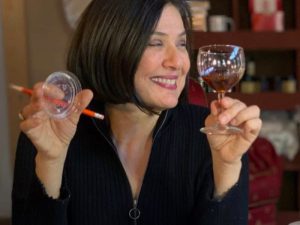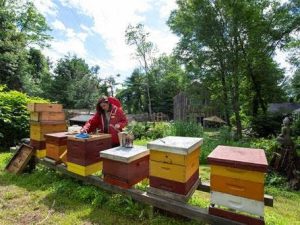I’m one of 2 honey sommeliers in the US — here’s how I ended up tasting this sweet but surprisingly complex substance for a career

Marina Marchese is one of two certified honey sommeliers in the United States. Marina Marchese
I’ve never really understood why no one talks about honey the way they talk about wine or cheese or olive oil.
There are thousands of different grapes, growing in different places, and each one produces a unique kind of wine.
The same is true of honey. There are thousands of botanical sources that make so many types of honey that it’s hard to even quantify.
In Bulgaria, for example, honey is made out of the coriander flower. In Greece, honey is made from thyme. Just in Italy alone, there are more than 25 types of honey.
Yet most people in the US are only familiar with “mass market” honey — a generic, blended version with a singular flavor profile.
My origin story
I came into the world of honey tasting by way of beekeeping.
I visited a honey bee hive for the first time in 1999. Like most people, I was terrified, even though I was wearing full protective gear, a veil, and a hat. Yet I was surprised to see how docile the bees were.

Marchese tending to her honey bee hive. Marina Marchese
A year later, I started my own hive. At first, it was just a hobby, but soon it turned into a full-fledged career. I began selling my own honey under the brand Red Bee at local farmers’ markets. Then I started collecting honey from various botanical sources. I also started making connections with beekeepers across the country by attending conferences.
The deeper I delved into this realm, the more I wondered why there wasn’t a central database that catalogued every variety of honey. I read everything by the US Department of Agriculture. I read everything by Eva Crane, the mathematician who devoted her life to researching bees and bee-keeping. I started going to as many honey shows as I could.
Eventually, I stumbled upon a program in Italy called The Italian National Register of Experts in the Sensory Analysis of Honey. The goal was to teach the sensory analysis of honey — similar to what exists for the smelling or tasting of wine.
The program has been operating for 40 years and has three levels. For your final certification, you need to pass a formal exam. There’s an oral portion, a written portion, and a blind tasting, where you must identify the botanical source of 18 honeys by smell and taste alone.
I was the first US citizen to pass through all three rounds of the program. Since then there has been a second, which only underscores the point that there are very few honey sommeliers in the country.
To read the whole article go to; I’m a Honey Sommelier, Here’s How I Landed the Job (businessinsider.com)
We are here to share current happenings in the bee industry. Bee Culture gathers and shares articles published by outside sources. For more information about this specific article, please visit the original publish source: I’m a Honey Sommelier, Here’s How I Landed the Job (businessinsider.com)








